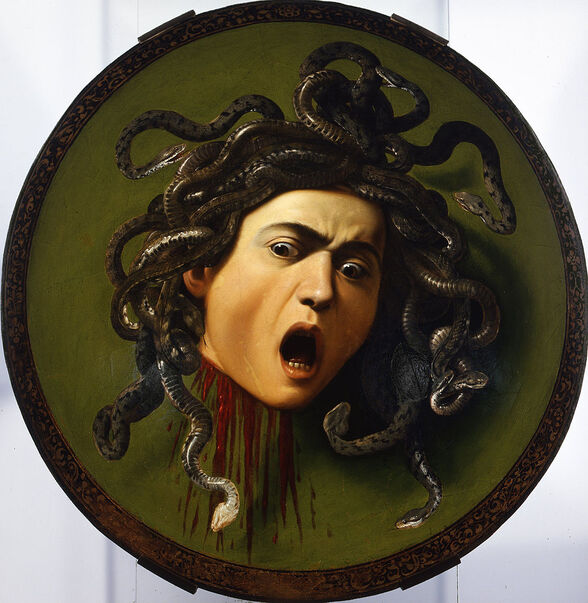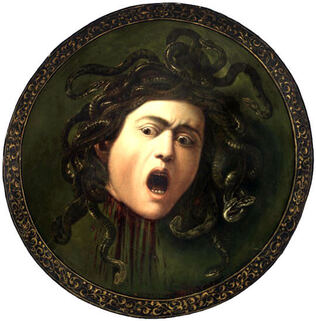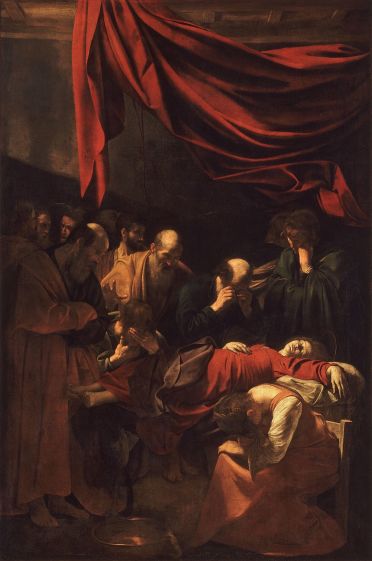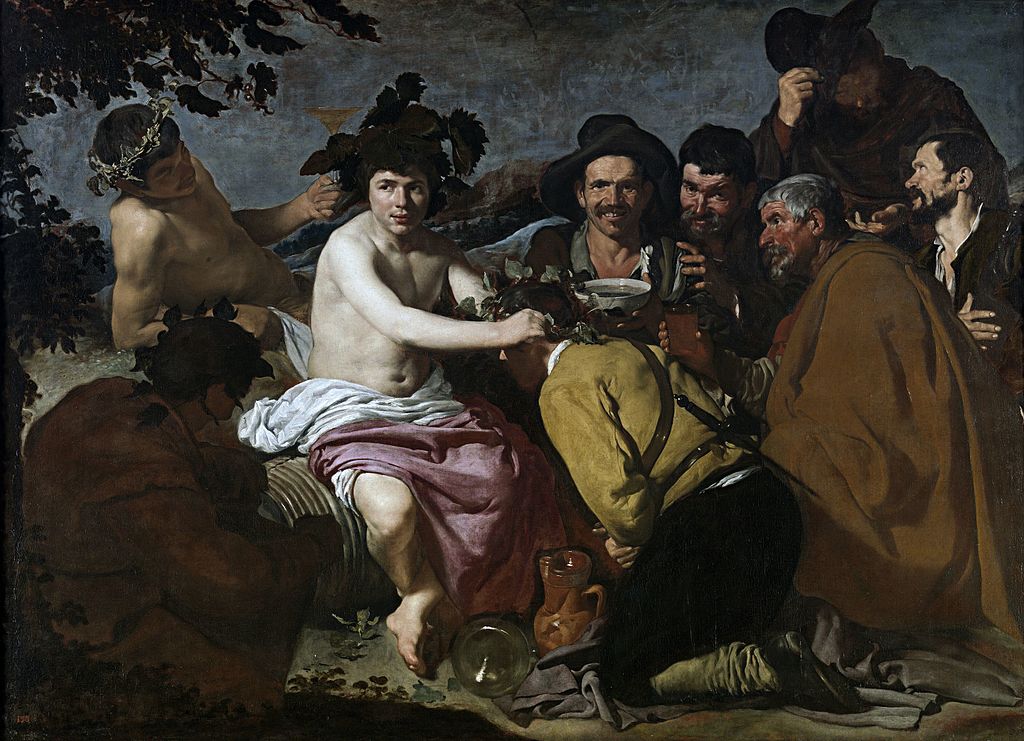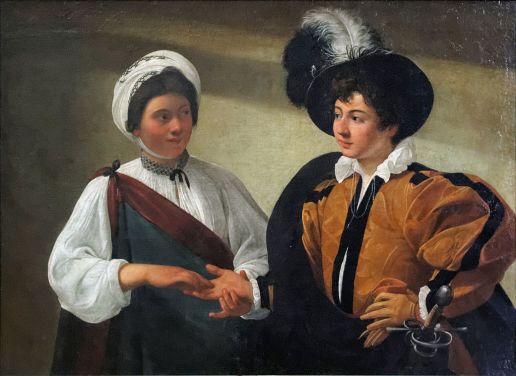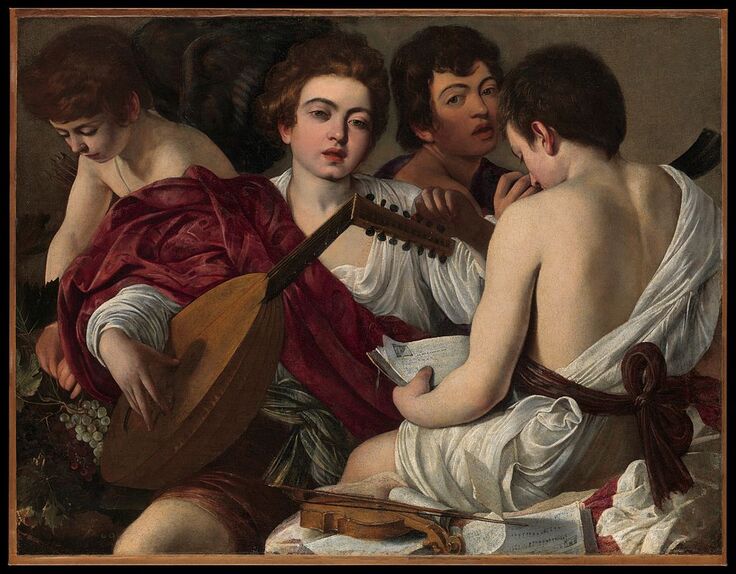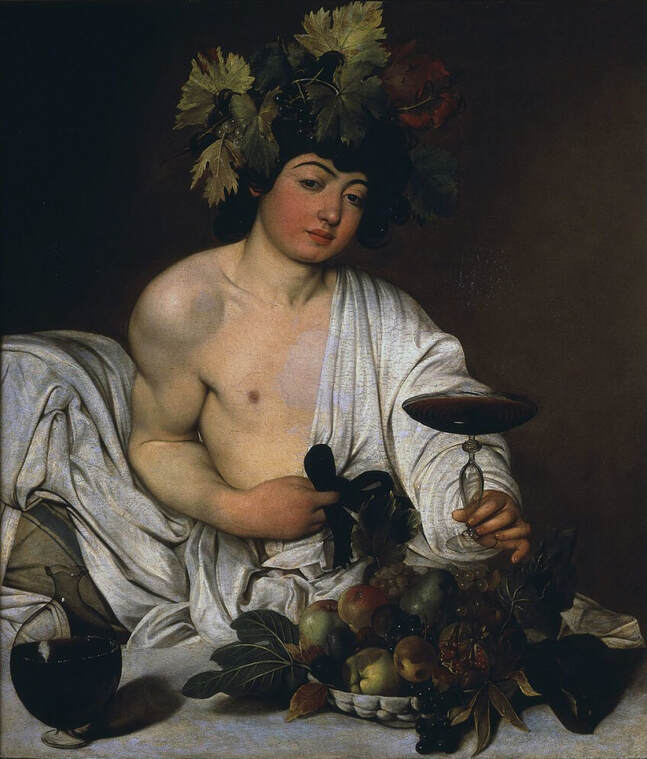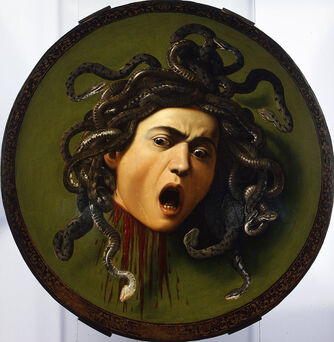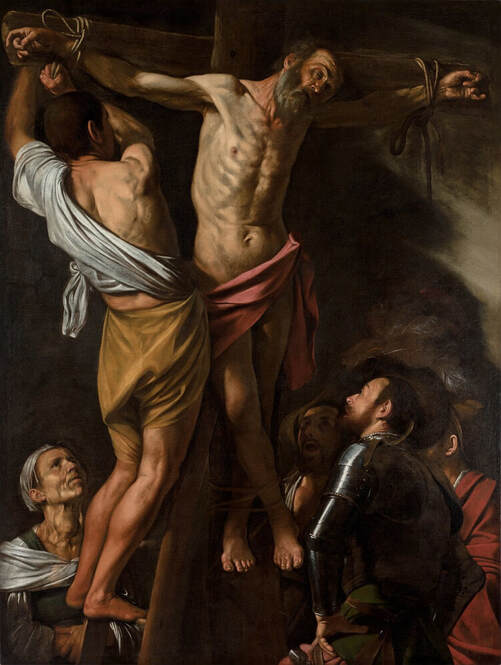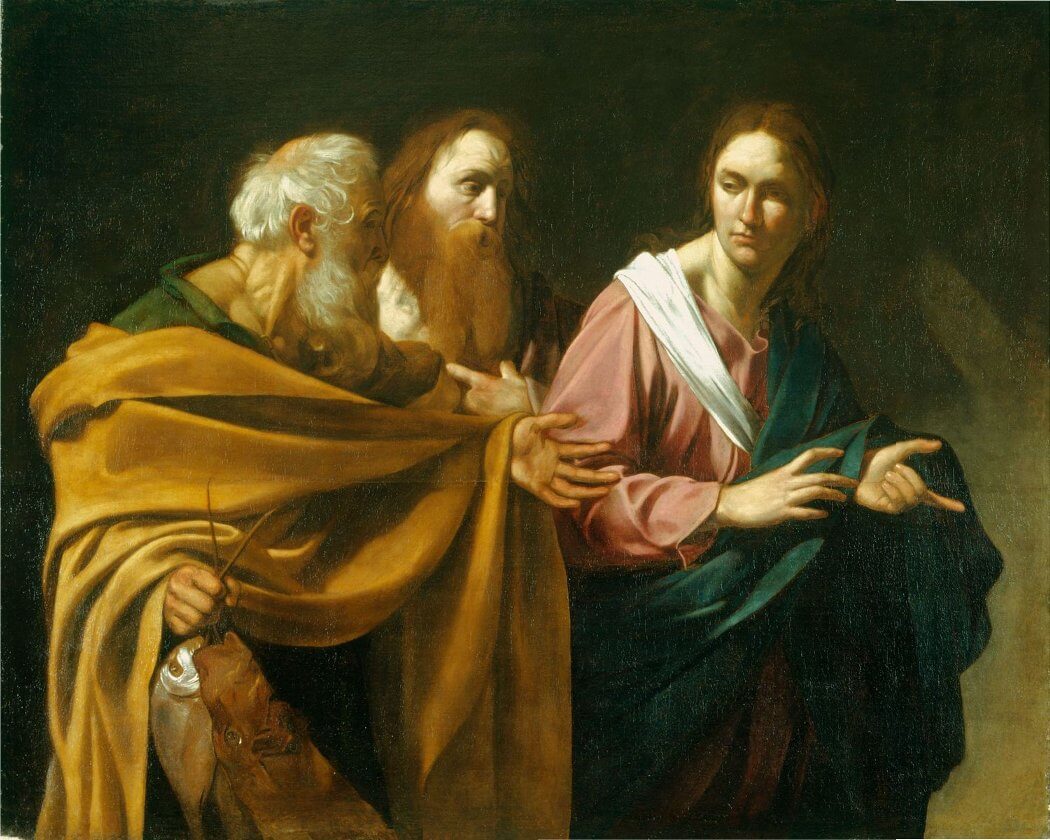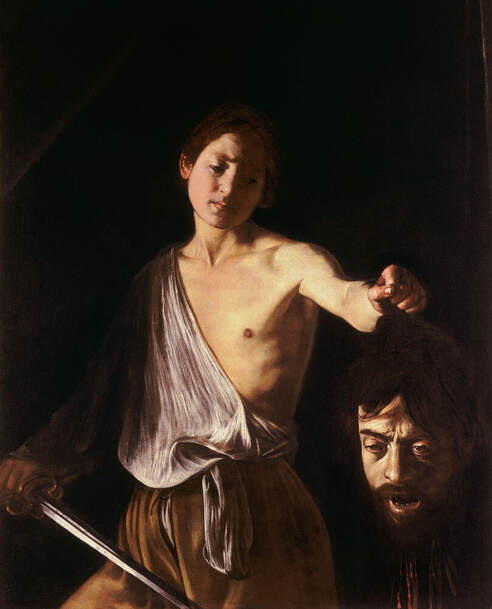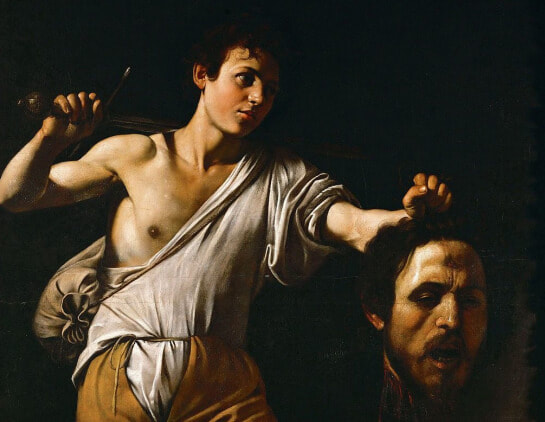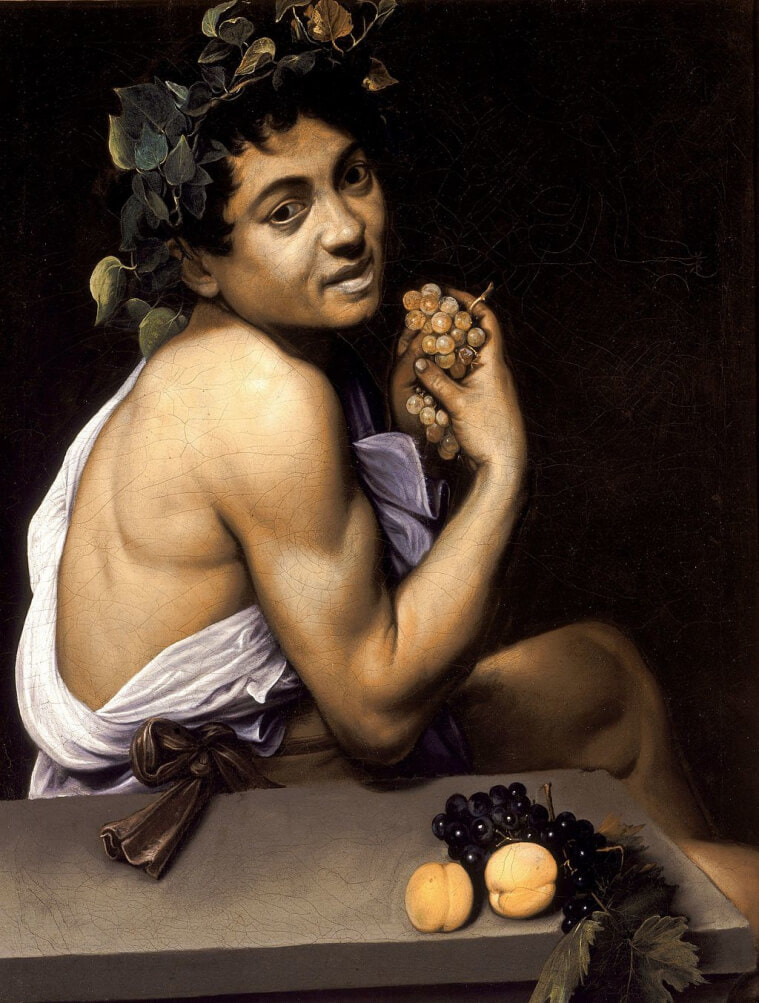|
Where? Room 96 of the Uffizi Museum
When? 1597 Commissioned by? Cardinal del Monte, who gave it as a gift to Ferdinando I de Medici, the Grand Duke of Tuscany What do you see? A depiction of the head of Medusa painted on a circular and curved wooden shield. Medusa is a figure described in Greek mythology. With her glance she could turn people who looked at her into stone. Instead of normal hair she has living, venomous snakes on her head. The snakes are watersnakes from the Tiber river as those were the best type of snakes Caravaggio could find nearby. I count at least eight snakes on her head. The blood streams out of her head as she has just been killed by the Greek demigod Perseus. This painting shows the moment that Medusa is looking at the reflective shield that Perseus is holding (which according to the myth actually happened just before she got beheaded). She realizes that her head is separated from her body, but that she is still conscious. You can see this realization by the horror in her eyes. As the painting is created on a shield, Caravaggio’s idea was that this painting actually represents the view of the shield as held by Perseus just after he killed Medusa. It is also interesting to have a closer look at Caravaggio’s use of light and shadow in this painting. Do you see how Caravaggio used these contrasts to show the head of Medusa as a three-dimensional object?
Who is Caravaggio? Michelangelo Merisa da Caravaggio (1571-1610) was trained by Simone Peterzano, who was in turn trained by Titian. He used a realistic painting style, paying attention to both the physical and emotional state of the subjects he painted. He combined this with a beautiful contrast between light and shadow in his paintings. He was a brilliant and unconventional artist.
During his life he received quite some commissions for religious paintings. However, Caravaggio always knew to how add some dark elements to the painting. He liked to use beggars, criminals, and prostitutes as models for his paintings, which would often give unexpected outcomes for familiar biblical scenes. Two beautiful examples of his religious paintings are the Death of the Virgin in the Louvre and The Entombment of Christ in the Vatican Museums.
Who is Medusa? In Greek mythology, Medusa was one of three sisters (Stheno, Euryale, and Medusa) who were often referred to as Gorgons. Both Stheno and Euryale were immortal, but Medusa was not. They were daughters of Phorcys (a sea god) and his sister Ceto (a sea goddess).
According to the Roman poet Ovid, Medusa was a beautiful young woman. However, after Poseidon (the god of the sea) made love to her in Athena’s temple, Athena (the goddess of wisdom and war) changed her beautiful locks into living, venomous snakes (in other mythological stories the three sisters were already born with snakes on their heads). Medusa had a horrific facial expression that could turn people (or according to some, only men) who looked at her into stone. The Greek hero Perseus, a demigod, used a shining shield that he got from the goddess Athena to avoid looking at her directly and succeeded to cut off her head. He used her head as a weapon afterwards as it retained its power to turn people who looked at it into stone. Perseus ultimately gave the head of Medusa to the goddess Athena, who placed the head on her shield (which is what is depicted in this painting). When the head of Medusa was cut off, two creatures arose from Medusa’s body: Pegasus, a winged horse, and Chryasor, a giant with a golden sword. Medusa in art? Medusa has been a popular subject in art. Famous artists have used her story as the inspiration for their artwork. Well known versions include:
Fun fact: Monica Favaro and colleagues published an academic study about the materials that were used in this painting and the evolution of these materials over time.
Interested in a copy for yourself? Poster or canvas (Amazon links).
2 Comments
Where? Room VIII of the Galleria Borghese
When? 1593-1594 Commissioned by? Unknown; Caravaggio probably used this painting to market himself for commissions. What do you see? A self-portrait of Caravaggio. He poses as the Roman god Bacchus, the god of grape harvest, wine, and intoxication. He is half-naked, wearing a white robe, and the ribbon around his robe lies on the table. We can see his muscular shoulder and arm. However, Bacchus does not look healthy. His skin is yellow and the white part of his eyes as well. Also, he has bluish lips. He wears a crown of ivy leaves on his head. He folds his hands and holds a bunch of white/yellow grapes between them. Bacchus sits at a stone table with on top a bunch of healthy black grapes, two peaches which have a similar color as Bacchus’ skin, and some vine leaves. Backstory: This painting is also known as ‘Sick Bacchus’ or ‘Self-Portrait as Bacchus.’ Caravaggio used a mirror to paint this work as he did more often later in his career. He probably painted it between 1593 and 1594. In 1607, the painting was confiscated by the Pope because of tax evasion by its owner, Giuseppe Cesari. The Pope gave the painting to his nephew, Scipione Caffarelli-Borghese. The painting was still reported to be in the Borghese collection in 1693. As the painting does not have a signature of Caravaggio, over the next centuries, it was attributed to several other painters. In 1927, it was attributed to Caravaggio again, and the large majority of people believes that this is a real Caravaggio. Who is Bacchus? Known in Greek mythology as Dionysus, Bacchus was the son of Zeus and Semele. He was the god of ecstasy, fertility, grape harvest, wine, and winemaking. He was a popular subject for artists as it allowed them to depict earthly pleasures. Around 1595, Caravaggio painted another painting of Bacchus which is in the Uffizi Museum. In contrast to his first painting, Bacchus looks quite healthy in that painting. Another example of an artist who has used Bacchus as the subject of his art is Diego Velázquez. He painted The Triumph of Bacchus in the Prado Museum.
Symbolism: The crown of ivy leaves is a symbol of Bacchus. Ivy was a sacred plant for Bacchus as it was thought to possess the power of preventing intoxication. The bunch of grapes also contains some rotten grapes. This is a symbol of death which is always looming and must have been in the mind of Caravaggio when he was in the hospital for a long time before he created this painting. At the same time, he holds the bunch of grapes close to his mouth suggesting that he is available for some intimacy. This suggestion is also emphasized by the ribbon of his robe, which is explicitly shown on the table and is ready to be opened. Moreover, the two peaches on the table symbolize a desire to be together with someone else.
Who is Caravaggio? Michelangelo Merisi Caravaggio (1571-1610) was born in Caravaggio near Milan, Italy. In 1592, he fled to Rome due to some trouble with the police. He arrived in Rome with almost no money and no place to live. Moreover, he got seriously ill and spent six months in the hospital. Luckily, he was a very talented painter. During his recovery, he painted Young Sick Bacchus. At the beginning of his career, he focused on naturally and realistically depicting human subjects and other elements in his paintings. This was very uncommon and makes the work of Caravaggio unique. To emphasize the imperfections of life, Caravaggio would get the models for his paintings from the streets (like beggars and prostitutes) and would buy some fruit on the market, accepting the fact that the fruit did not look perfect. Early in his career, Caravaggio also painted The Fortune Teller in the Louvre and the Capitoline Museums, and The Musicians in the Metropolitan Museum of Art.
Fun fact: Caravaggio was recovering from a serious illness when he painted this work. There are several theories on why he was in the hospital, ranging from a serious kick of a horse to malaria. However, during his recovery, there were still signs of sickness as we can see in this painting. He has jaundice, which leads to a yellowing of the skin and the white part of your eyes. It makes sense that Caravaggio used himself as the model for this painting. He was very poor in the beginning of his career (and also not rich during the rest of his life), and Caravaggio himself was the cheapest model he could find for this painting.
Interested in a copy for yourself? Poster or canvas.
Where? Room 21 in the Palatine Gallery in the Palazzo Pitti
When? 1608 Commissioned by? Fra Francesco dell'Antella, the Florentine secretary to Alof de Wignacourt, who was the Grand Master of Malta What do you see? A somewhat chubby child is sleeping. The child represents Cupid, the god of desire, erotic love, affection, and attraction. Cupid is resting with his head on top of his quiver with arrows and is holding an arrow (with a small piece of red) in his left hand. You can also recognize the bow with a broken string in front of his legs. The wings of Cupid are also present. While the left wing is clearly visible, the black background hides a large part of the right wing of Cupid. Backstory: Caravaggio created this painting while he was on Malta, where he became an honorary knight. It is the only painting he created there that is known with certainty, evidenced by an inscription on the back of the painting (though he probably created several others in Malta as well). The sleeping Cupid became a popular topic in Renaissance art after Michelangelo’s sculpture of a sleeping Cupid in 1496 (this sculpture is lost, probably it got destroyed in a fire in London in 1698). Michelangelo’s sculpture, in turn, was inspired by old Greek statues of the sleeping Cupid. Symbolism: The depiction of Cupid, with his broken bowstring and his arrows aside, represents the abandonment of earthly pleasures. Whereas an active Cupid is typically seen as a symbol for spreading the love, this particular representation has a completely different meaning. The painting was commissioned by a friar to remind him and others of their vow of chastity. Who is Cupid? Cupid (Eros in Greek) is the god of desire, erotic love, affection, and attraction. He is the son of Venus and Mars. He is often portrayed as a chubby boy. His main attributes are his bow and arrow, and he typically has two kinds of arrows. The first kind are arrows with a sharp golden tip, which can fill someone with uncontrollable desire. The second kind are arrows with a blunt tip of lead, which can fill someone with aversion and the desire to flee. Why Cupid? As Cupid can both fill someone with uncontrollable desire and fill someone with aversion, he makes a great subject for allegories. Love and hate have always been great topics for art as they represent some of the strongest emotions that people possess. The particular way in which he is represented in an artwork can tell a wide variety of different stories. The subject of a sleeping Cupid was already frequently used by the ancient Greek, who mainly used this subject as a symbol of love as an everlasting emotion, which is present whether someone is awake or asleep. Caravaggio has also included Cupid in some of this other works, such as his painting The Musicians in the Metropolitan Museum of Art.
Who is Caravaggio? Michelangelo Merisi da Caravaggio (1571-1610) is a student of Simone Peterzano, who in turn was a student of Titian. Caravaggio had an important influence on the formation of the Baroque period. So much so, that the followers of his style are referred to as Caravaggisti. While Caravaggio never had a school to share his techniques with others, his work has had a big influence on artists like Rubens, Bernini, and (indirectly) Rembrandt. Caravaggio created many masterpieces including his Medusa in the Uffizi Museum and The Fortune Teller in the Louvre.
Fun fact: Quite some people have commented on this painting, stating that the child looks dead. An analysis by a doctor, published in the famous medical academic journal The Lancet, states that the sleeping Cupid suffers from juvenile rheumatoid arthritis. Symptoms include the yellowish skin of the child (indicating jaundice), the blue/purple color in the lips and ears indicates a low level of oxygen saturation, his body seems to suffer from edema, and his joints are inflamed. The question remains why Caravaggio would paint a sick or dead child. It could be an effective way to deliver the message of the painting, or it could be a macabre joke of Caravaggio (which is certainly not impossible given the turbulent life that he lived).
Interested in a copy for yourself? Poster or canvas
Where? Room 12 of the Pinacoteca in the Vatican Museums
When? 1602-1604 Commissioned by? The Vittrici (or Vittrice) family, probably Gerolamo Vittrici or his son Alessandro Vittrici. What do you see? This painting shows five people in the middle of the night and the lifeless body of Jesus. Notice that the body of Jesus is clean and there is no blood, although you can see a wound in his side. The chest and arm of Jesus are pale indicating that he has died already. The people are standing on top of a big stone at the entrance of the tomb where Jesus would be lowered down and buried. The person on the right in the brown robe is Nicodemus. He is holding the knees of Jesus and looks into the direction where the body of Jesus would be placed. On the other side, a young Saint John, who can be identified by his red cloth, is putting an arm under the shoulders of Jesus. Behind Nicodemus are three women who express their emotions in different ways. One raises her hands in the air (it is not clear which Mary this is), the other is crying and drying her tears (this may be Mary Magdalene), and the third is the old Virgin Mary who is looking sadly at the body of Jesus. Above the head of Jesus, you can see the hand of the Virgin Mary. In the left foreground, you can see a great mullein plant, which is a symbol of driving away evil spirits. Finally, notice that Caravaggio chose for a black background without any landscape or architecture, which makes us focus completely on the figures in the foreground. Backstory: This painting served as an altarpiece in one of the Chapels (the Cappella della Pietà) in the Santa Maria in Vallicella church (also known as the Chiesa Nuova) in Rome. In 1797, this painting was removed from the church by Napoleon, but around 1816 it returned to Rome to hang in the Vatican Museums. Several well-known artists, including Cézanne, Gericault, and Rubens, have used this painting as an example for their own work, often with some modifications. A replica of this painting is in the Chiesa Nuova. A version of Rubens is quite similar to the original by Caravaggio. This painting is now in the National Gallery of Canada. However, there are some differences between the two paintings, such as Saint John already stepping down with one foot into the grave. Another difference is that Rubens has replaced Nicodemus by Joseph of Arimathea.
The Santa Maria in Vallicella church: This church is also called the Chiesa Nuova. It is located in Rome next to the Corso Vittorio Emanuele II. This is the main church for the Oratorians. This is a community of secular priests recognized by the Pope and the members of the community are not bound by vows but bound by a voluntary bond of charity. The church is richly decorated with gold, frescos, paintings, and altarpieces. The church got into serious disrepair during the 19th century, but in 2006 a major restoration was completed. Nowadays, the church is still in active use.
Who is Caravaggio? Michelangelo Merisi da Caravaggio (1571-1610) was born in Milan and grew up in Caravaggio (which is where his name comes from). He was a brilliant painter, but he led a troubled life. After some incidents with the police, he fled Milan in 1592 and moved to Rome. Typical for his work is that he incorporated a realistic depiction of the physical and emotional state of his subjects. He painted a variety of different works, including religious paintings, mythological paintings, still lifes, and self-portraits. Besides the painting on the entombment, Death of the Virgin in the Louvre is another example of a great religious work by Caravaggio. An example of a great mythological painting is his work of Bacchus in the Uffizi Museum.
Fun fact: The painting is quite dark. While this was the intention of Caravaggio and may partly be due to the exposure to light over time, Caravaggio also took the place where the painting would be placed into account when choosing the colors he used for the painting. He considered both how the light would fall on the painting and the height at which the painting would be placed. So, when removing his paintings from their intended location, the quality of his works sometimes seems to be worse than if it would have stayed in its intended place.
To fully appreciate this painting, one should attend the mass in the Chiesa Nuova where a replica of this painting hangs on its original location. The painting hangs about five feet above the altar step, which is at eye-level for the priest when the body of Christ is remembered during the mass. The attendees to the mass would look up to this painting.
Where? Room 621 of the Metropolitan Museum of Art
When? 1595 Commissioned by? Cardinal Francesco Maria del Monte, the patron of Caravaggio. What do you see? Four boys dressed in semi-classical costumes. Three of the boys are playing music. The central figure is holding a lute and is thought to be Mario Minniti, a friend of Caravaggio. His eyes are moist and full of tears. The second boy from the right is a self-portrait of Caravaggio, who is playing a cornetto (a horn-like wind instrument of about two feet long; you can see the end of the instrument on the top right of the painting). The boy on the right is studying the musical score. The boy on the left is representing Cupid and is reaching for some grapes. In the foreground are two open books with musical scores as well as an unused violin. These elements seem to invite the viewer to participate with the musicians. Backstory: This painting is also known as the Concert of Youths. The boys are practicing madrigals, which are a secular (as opposed to religious) vocal music composition from the Renaissance. The song they are practicing deals with the sorrows of love. Symbolism: The boy on the left represents Cupid. The gathering of grapes by Cupid represents love. The grapes are also representing the fact that music should make the spirits light. Cupid has wings and arrows. The arrows are the main symbol of Cupid (together with the bow). Cupid typically has two kinds of arrows. Arrows with a sharp golden tip, which can fill someone with uncontrollable desire, and arrows with a blunt tip of lead, which can fill someone with aversion and the desire to flee. Cupid seems to have the latter type of arrows here. Why musicians? Musical scenes became popular during Caravaggio’s time, mainly due to the Church that started supporting various forms of music. Hence, the inspiration for this theme came from Cardinal Del Monte, who was heavily involved with the Church. Del Monte also organized various concerts at his palace. However, interestingly, the music that is played in this painting is nonreligious. Who is Francesco Maria del Monte? At age 24, Caravaggio entered the household of the Italian cardinal, diplomat, and art connoisseur, Francesco Maria del Monte (1549-1627). The cardinal paid Caravaggio for his work. Del Monte was an important art collector during his time in Rome and left a collection of about 600 paintings at his death. He commissioned more paintings from Caravaggio, including Bacchus (in the Uffizi Museum) and The Fortune Teller (in the Louvre). In addition to his love for paintings, Del Monte was also a big fan of music which explains the musical theme in this painting. In his large house, the Palazzo Madama, the cardinal hosted both artists like Caravaggio and various musicians. He paid for their musical education and gave them a place to stay.
Who is Caravaggio? Michelangelo Merisi da Caravaggio (1571-1610) was trained by Simone Peterzano, who was in turn trained by Titian. He used a realistic painting style, paying both attention to the physical and emotional state of the subjects he painted. He combined this with a brilliant contrast between light and shadow in his paintings.
Caravaggio lived a tumultuous life and was accused of murder, assault, many fights, and has served in prison. However, his sheer brilliance as an artist has given him a place in the history books. His painting style has had a big influence on the development of Baroque painting (which includes drama and an intense contrast between light and dark). Some well-known paintings by Caravaggio are his Medusa in the Uffizi Museum and Sleeping Cupid in the Palazzo Pitti.
Fun fact: This painting has been missing for centuries. While many artists in the 17th century mentioned this masterpiece, it only turned up in 1952, when the Metropolitan Museum of Art announced that the painting had been found and they included it in their museum. Less than two decades before, the painting had been sold for 100 pounds in England, where both the buyer and seller did not recognize that this was the missing painting of Caravaggio (mainly due to the bad state in which the painting was).
Interested in a copy for yourself? Poster or canvas.
Where? Room 97 of the Uffizi Museum
When? 1595-1598 Commissioned by? Cardinal del Monte, who gave it as a present to Ferdinando I de’ Medici, the Grand Duke of Tuscany. What do you see? A young Bacchus is holding a glass of wine in his left hand. He has a wreath of vine leaves and grapes on his head. It seems that he is wearing some makeup on his face. With his right hand, he is playing with the drawstrings of his half-opened robe. Bacchus is sitting on a chaise longue (a Roman type of chair/bench – also called a triclinium). On the stone table in front of him are a ceramic bowl of fruit and a jug of wine. The bowl of fruit contains both healthy and spoiled fruits as well as fresh green leaves and spoiled yellow leaves. Bacchus already seems a bit drunk and extends an invitation to the viewer to join him for a glass of wine and maybe something more… If you look carefully, you can see the ripples in the glass of wine to indicate the movement of the left arm of Bacchus towards the viewer. Backstory: This painting was created when Caravaggio was staying with his first patron, Cardinal del Monte in Rome. True to his unconventional style, Caravaggio painted an imperfect, limited, earthly version of Bacchus. This may be close to some of the figures he met in the many taverns and brothels that he liked to visit. Cardinal del Monte gave the painting away in 1608 to the Grand Duke of Tuscany on the occasion of the marriage of the Grand Duke’s son Cosimo II. The painting has long been unknown to the public as it stayed for centuries hidden in some of the private quarters of its owners. It was rediscovered in 1913 in the storage of the Uffizi Museum after which it was attributed to Caravaggio. Symbolism: The bowl with spoiled fruit is an example of a vanitas, which means ‘emptiness’. Vanitas refers in the traditional Christian view to the emptiness and worthlessness of all earthly goods and ambitions. Spoiled fruit is one common way to present this. It was appropriate to depict this fruit with Bacchus as he was associated with fertility and agriculture. Notice also the dirty fingernails of Bacchus. Some interpret this as a warning of the consequences of earthly pleasures, while other just attribute this to the style of Caravaggio (he painted in great detail what he saw, including dirty fingernails). The vine leaves in Bacchus’ hair are one of his sacred symbols, and that is how we can easily recognize him. Finally, it seems that Bacchus is wearing some makeup on his face, which is often associated with sexuality and strengthens the idea that he is inviting the viewer for more than a glass of wine. Who is Bacchus? Bacchus (in Greek Dionysus) is the god of the wine, fertility, madness, theatre, and religious ecstasy. He is the son of god Zeus and the mortal Semele.
Who is Caravaggio? Michelangelo Merisi da Caravaggio (1571-1610) was trained by Simone Peterzano, who was in turn trained by Titian. He used a realistic painting style, paying both attention to the physical and emotional state of the subjects he painted. He combined this with a brilliant contrast between light and shadow in his paintings.
Caravaggio had a tumultuous life and was accused of murder, assault, many fights, and he served in prison. However, his sheer brilliance as an artist has given him a place in the history books. His painting style has had a big influence on the development of Baroque painting (which includes drama and an intense contrast between light and dark). Among his many famous works are his Medusa in the Uffizi Museum and The Musicians in the Metropolitan Museum of Art.
Fun fact: Many experts believe that Caravaggio used a mirror to draw this painting such that he did not have to make the drawing first, but could immediately work on the painting. This means that the model for this painting offered the wine with his right hand, instead of the somewhat awkward way in which Bacchus is using his left hand. Another reason to believe that Caravaggio was using a mirror for this painting is that after a cleaning of the painting a very small self-portrait of Caravaggio working on a painting was revealed in the reflection of the jug of wine (but it is difficult to see).
Interested in a copy for yourself? Poster.
Where? Gallery 217 of the Cleveland Museum of Art
When? 1606-1607 Commissioned by? Probably Juan Alonso Pimentel de Herrera, the Count of Benavente, Spain, and the ruler of Naples. What do you see? The crucifixion of Saint Andrew. He is tied with ropes to a cross. Saint Andrew has just died, and Caravaggio shows great skill in depicting the moment that Saint Andrew transitions from life to death. You can see in Saint Andrew’s face the combination of a long-suffering and the relief that he can finally die. The executioner on the left stands on a ladder and is about to untighten a rope around the right wrist of Saint Andrew. He wants to take the dead body of the cross. On the bottom right are three other executioners. The man in the foreground, wearing the armor, is the governor of the region where Saint Andrew is crucified. The governor, Aegeas, ordered the crucifixion as Saint Andrew converted his wife to Christianity. He looks in a somewhat arrogant way at what just happened – the way in which Saint Andrew died. Behind him, you can see the open mouth of another executioner who is surprised by the event that just occurred. On the bottom left, a poor woman has her hands folded and seems to be in her thoughts. Backstory: Saint Andrew preached in Greece several years after Jesus had died. After he converted the wife of the governor to Christianity, the governor ordered his crucifixion in the city of Patras. Instead of nailing him on the cross, like what happened to Jesus, they bound Saint Andrew to the cross such that he would suffer longer. According to some legends, Saint Andrew continued to preach from the cross to a large crowd for two straight days. At that time, the crowd demanded his release from the cross, and the governor agreed with this request to prevent riots. However, right at the moment that they wanted to take Saint Andrew of the cross alive, the arms of the executioners froze, and God honored the prayer of Saint Andrew to die on the cross. Who is Saint Andrew? Andrew the Apostle was one of the disciples that was closest to Jesus. After the death of Jesus, he traveled the world to preach the Christian religion. It has been reported that he preached in Greece, Romania, Russia, Turkey, and Ukraine. Saint Andrew is the brother of Saint Peter. They were the first disciples of Jesus, and are mentioned in all four gospels. Between 1603 and 1606, Caravaggio has painted The Calling of Saints Peter and Andrew. This painting is part of the British Royal Collection and on display in the Hampton Court Palace in England. In 1601, Caravaggio also painted the Crucifixion of Saint Peter, which is in the Basilica of Santa Maria del Popolo in Rome.
A real Caravaggio? Caravaggio painted this work while he was in Naples. In 1610, the Spanish ruler of Naples, Juan Alonso Pimentel de Herrera, took the painting with him to Spain. It was in possession of his family until at least 1653, but there is no evidence of the existence of this painting after that. It was lost for over 300 years.
In 1973, it appeared again in the collection of a Spanish art collector, but it took a few years to show that this was a real Caravaggio. The reason is that are at least three high-quality copies of this painting. Comparing the four versions, only the current version displays the superb painting skills of Caravaggio. The Cleveland Museum of Art acquired the painting in 1976. However, as of recently, one of the other three versions is also considered to be a real Caravaggio painting. Saint Andrew’s cross: The most common story about the death of Saint Andrew is that he was crucified on an x-shaped cross. This is called a Saint Andrew’s cross. However, according to one of the earliest sources on the death of Saint Andrew, the Acts of Andrew, he was bound to a normally-shaped (upright) cross. At the time that Caravaggio painted this work, there was still debate about the true shape of Saint Andrew’s cross, and Caravaggio chose for the upright cross. Who is Caravaggio? Michelangelo Merisi da Caravaggio was born in 1573 in Milan and died in 1610 in Porto Ercole, Italy. He is one of the founders of Baroque painting. He was a master in realistically depicting both the physical and mental state of the subjects in his paintings. He was also very innovative in the way he used the contrast between light and dark to emphasize certain aspects in his works. Most of his works are famous nowadays. One example is Bacchus which is in the Uffizi Museum in Florence. Another example is The Musicians in the Metropolitan Museum of Art in New York.
Fun fact: Caravaggio lived a turbulent life, and this is reflected in his art. He had a preference for more cruel topics. For his paintings, he frequently used people he met on the streets as models. These people ranged from prostitutes to criminals, and from con people to sick people. Unlike many other artists, Caravaggio painted them realistically and did not idealize them. As a result, the figures in his paintings have provided quite some inspiration for medical professionals who liked to diagnose some of the diseases that they would recognize in his work.
An example of the diseases found in Caravaggio's models is the woman in the lower left of this painting. She has been diagnosed to suffer from nodular goiter, an enlarged thyroid gland, which leads to a large swelling in the neck. This disease was quite prevalent in Italy, and especially near Naples, at the beginning of the 17th century. The disease still exists today. As an example, both Former U.S. President George H. W. Bush and his wife Barbara have been diagnosed with goiter during their life. Interested in a copy for yourself? Poster or canvas.
Where? Room VIII of the Galleria Borghese
When? Around 1610 What do you see? David holds the head of Goliath after he defeated Goliath in a one-to-one battle. The painting is full of contrasts. David is depicted in the light as a young, strong, and lively man. He wears a wrinkled white cloth that is tucked into his beige pants. He is clean-shaven. He holds the sword of Goliath in his right hand and the head of Goliath in his left hand. He looks at the head of Goliath with a calm but somewhat sad expression. Most of the composition is dedicated to David. In contrast, only the lower right of the composition is dedicated to Goliath who is depicted as an ugly, old, and defeated man. You can see the blood on his forehead, which is the place where David hit him with a stone. His eyes are still knitted, showing his reaction when he saw the stone flying towards his forehead. He has a large beard and an open mouth with rotten teeth. His head is already decaying, and a large amount of blood is dripping out of the bottom. On top of the blade of the sword is an inscription reading ‘H-AS OS.’ This refers to the Latin for ‘humilitas occidit superbiam,’ which means ‘humility kills pride.’ Backstory: Caravaggio probably painted this work while he was in Naples and this may have been the last work that he completed during his life. However, there is some doubt about the exact date of this painting. Some people think that it could have been painted as early as 1605. Popular belief, though, is that this is indeed the last painting by Caravaggio (which makes this painting more special). Francesco Boneri (also known as Cecco del Caravaggio, but no family of Caravaggio) is probably the model for David. He was a servant and pupil of Caravaggio and a moderately talented painter himself. However, some people believe that David is based on a self-portrait of a younger Caravaggio. Other versions by Caravaggio: Caravaggio painted David with the Head of Goliath a total of three times. In 1600, he painted his first version which is on display in the Prado Museum in Madrid. In this version, David is tying the hair of Goliath with a rope after he cut off his head. In 1607, Caravaggio painted his second version which is on display in the Kunsthistorisches Museum in Vienna. This second version is most similar to his final version. The main differences are the age of of Goliath and the way in which David holds his sword.
David and Goliath: 1 Samuel 17 describes the story of David and Goliath. Israel was at war with the Philistines. The Philistines had a hero called Goliath who was over 9 feet (2.75 meters) tall. Goliath proposed every day to the Israelites that instead of letting the armies fight each other, they should send one man to fight him. If Goliath would win the fight, the Israelites would become slaves of the Philistines, and if Goliath would lose, the Philistines would become slaves of the Israelites.
David convinced King Saul that he should fight Goliath. He went out of the army camp to meet Goliath, wearing no armor, only bringing a walking stick, a sling, and a bag with five smooth stones. He put a stone in his sling and threw it at Goliath, hitting him between his eyes. Goliath fell, and David took Goliath’s sword to behead him. He took the head of Goliath back to Jerusalem but kept the sword and spear for himself. Who is Caravaggio? Michelangelo Merisi da Caravaggio (1571-1610) was born in Caravaggio near Milan, Italy. Caravaggio lived a turbulent life, and in 1606 he killed a man (though it is not clear whether that was intentional). To avoid a conviction, he fled and lived until 1610 in Naples, Malta, and Sicily. In 1610, he had hopes that he would be pardoned for his crime, and he returned by boat to Rome with several of his paintings. When the ship arrives near Rome, Caravaggio gets arrested, and the ship leaves with his belonging for Porto Ercole. Caravaggio pays a bond to get out of jail and starts to follow the ship on foot to recover his belongings. However, he gets ill on the way and dies from a fever in Porto Ercole on July 18, 1610. While he died young, Caravaggio has left behind many popular paintings, including his The Crucifixion of Saint Andrew from 1606-1607 in the Cleveland Museum of Art and Sleeping Cupid from 1608 in the Palazzo Pitti.
Fun fact: Caravaggio probably used his own face as the model for Goliath in this painting. There are different explanations for why he did this. The conventional explanation is that he used himself as the model for Goliath to ask forgiveness from the Pope for the crimes he committed while he was in Rome.
An alternative explanation is that Caravaggio was just a rebel at heart and this was another way in which he expressed his rebellious nature. If one also believes that David is modeled after a younger Caravaggio, it would provide a more bizarre explanation for this painting. Specifically, it would mean that the young Caravaggio (through his wild behavior) has destroyed the life of the older Caravaggio. He used himself as a model in multiple paintings during his career, including Young Sick Bacchus in the Galleria Borghese and Medusa in the Uffizi Museum. Interested in a copy for yourself? Poster or canvas.
Where? Room 6 of the Prado Museum
When? Around 1600 Commissioned by? Unknown What do you see? David is tying the hair of Goliath with a rope after he beheaded him. This would allow him to carry the head with him and show it as proof that he killed Goliath. David wears a white fabric that he tucked into his beige pants. He bends down with his left knee on top of the shoulders of the beheaded body of Goliath. David is concentrated on his task and does not show any sign of triumph. It seems a serious and necessary task that he is completing. On the left, we can see the large right hand of the giant. Goliath has thick curly hair and a black beard. We can also see the wound on his forehead where the stone from David’s sling hit him. Caravaggio created a strong contrast between light and dark to emphasize the important body parts in this painting. The right leg, back, and arms of David are in the light, as are the head, shoulders, and right hand of Goliath. Backstory: The exact date that Caravaggio painted this work is unclear, but experts believe that he created this between 1596 and 1600. The painting was taken to Spain after Caravaggio completed it. There, it had a big impact on the Spanish artists of that time. This painting is based on the Biblical story of David and Goliath in 1 Samuel 17. However, this story does not mention that David used a rope to tie the hair of Goliath. This is just a free interpretation of the Biblical story by Caravaggio. Other versions by Caravaggio: Caravaggio painted David with the Head of Goliath a total of three times at different stages of his career. In 1607, he painted his second version, which is on display in the Kunsthistorisches Museum in Vienna. In this version, David grabs the hair of Goliath to hold his head in his hand. The third version from 1610 is in the Galleria Borghese in Rome. The second and third versions are quite similar. The main differences are the age of the head of Goliath and the way in which David holds his sword.
David and Goliath: 1 Samuel 17 describes the story of David and Goliath. Israel was at war with the Philistines. The Philistines had a hero called Goliath who was over 9 feet (2.75 meters) tall. Goliath proposed every day to the Israelites that instead of letting the armies fight each other, they should send one man to fight him. If Goliath would win the fight, the Israelites would become slaves of the Philistines, and if Goliath would lose, the Philistines would become slaves of the Israelites.
David convinced King Saul that he should fight Goliath. He went out of the army camp to meet Goliath, wearing no armor but bringing a walking stick, a sling, and a bag with five smooth stones. He put a stone in his sling and threw it at Goliath, hitting him between his eyes. Goliath fell, and David took Goliath’s sword to kill him by cutting off his head. He took the head of Goliath back to Jerusalem but kept his sword and spear for himself. Who is Caravaggio? Michelangelo Merisi da Caravaggio (1571-1610) was born in Caravaggio near Milan, Italy. In 1592, he fled to Rome to escape a conviction in Milan. Around 1600, he became very popular and was probably the most sought-after painter in Rome. He received the most prestigious commissions, and many people enjoyed the contrasts, drama, and emotions he included in his works. In the years after he painted the first version of David with the Head of Goliath, Caravaggio painted several other masterpieces, including The Entombment of Christ between 1602 and 1604 in the Vatican Museums and Death of the Virgin between 1601 and 1606 in the Louvre.
Fun fact: X-ray analysis revealed that Caravaggio initially wanted to paint a much more expressive version of Goliath. Underneath the canvas are traces of another design of the head of Goliath. In that design, Goliath has a much more terrifying expression on his face and his eyes almost pop out of his head. This version was more like the painting of Medusa of which Caravaggio painted two versions. The first version from 1596 is in a private collection and the second version, from 1597, is in the Uffizi Museum. However, the unknown commissioner of David with the Head of Goliath in the Prado Museum probably rejected this initial design after which Caravaggio settled on a more conservative version of Goliath’s head.
Where? First floor, room 712 of the Denon wing in the Louvre
When? Between 1595 and 1598 Commissioned by? Cardinal Francesco Maria Del Monte What do you see? On the left is a gypsy woman. She is wearing a white shirt, a blanket fastened around her shoulder, and a wrap around her head. On the right is a young man from the upper class. The nobleman is dressed in an expensive brown and black jacket, a feathered hat, and a glove on his left hand (and in that same hand he is holding the glove of his other hand). He is also wearing a sword with a rounded knob (called a pommel) on the top, which seems to almost stick out of the painting. Caravaggio is depicting a scene that could have been observed at that time in the streets of Rome. The gypsy woman is reading the right-hand palm of the young man to tell him his about this future. The woman is looking directly at the young man, who is looking back and is distracted by her beauty. In the meantime, the woman is stealing an expensive ring from his finger. You cannot see the ring, but we know that this is what the girl is doing based on another version of this painting which is shown below. Backstory: Caravaggio probably used his roommate, Mario Minniti, a painter himself, as the model for the young man, and he probably asked a gypsy from the streets as the model for the woman. In 1665, the Italian Prince Camillo Doria Pamphili gave this painting to Louis XIV, and this is how it eventually got to the Louvre. This painting is the second version of this subject by Caravaggio. Around 1594, Caravaggio had painted the original version of this subject which is in the Capitoline Museums in Rome. Caravaggio painted more often multiple versions of a painting, such as, for example, with his Medusa paintings of which one is in the Uffizi Museum in Florence. In The Fortune Teller, Caravaggio differentiates himself from his contemporary and earlier Italian painters by not focusing on biblical or classical themes, but by creating a, so-called, genre painting. This is a painting based on scenes observed in everyday life. Genre paintings would become quite popular during the 17th century among painters like Vermeer and Rembrandt.
Differences between the two versions: The second version of this painting in the Louvre seems to be an improvement over the first version as Caravaggio made several changes that are not obvious at first sight.
What lessons can we learn? In this painting, Caravaggio expresses the bad reputation of the gypsies at that time as they were known to be untrustworthy and for stealing things from the richer people. He also expresses the lesson that female beauty easily deceives young men. Caravaggio was one of the first artists to depict the theme of the fortune teller, and this topic has been the subject of quite some future artworks. For example, Georges de La Tour painted around 1630 his version of The Fortune Teller in the Metropolitan Museum of Art.
Who is Caravaggio? Michelangelo Merisi da Caravaggio (1571-1610) was born in Milan, but when he was five years old, his family moved to Caravaggio (which explains his surname). After some trouble with the police, he left for Rome in 1592. There, he developed a unique style which combined a realistic depiction of the physical and emotional state of his subjects with an innovative way to include light in his paintings. His work was the basis for the Baroque movement, and he has influenced many future, well-known painters, including Rubens and Rembrandt. Two other well-known works by Caravaggio that he created around the same time as the above painting are Bacchus (in the Uffizi Museum) and The Musicians (in the Metropolitan Museum of Art).
Fun fact: During the time that Caravaggio painted this work, he lived together with another painter, Mario Minniti. His roommate served as a model for quite some of Caravaggio’s paintings around that time, including the current painting, Bacchus, The Musicians, and The Lute Player.
In paintings after 1600, Minnite does not serve as a model anymore for Caravaggio as Minniti moved out to get married. This marriage got Caravaggio very angry. However, later on, their paths crossed again, and they allegedly were both involved in the killing of a man during a street fight in 1606. After this incident, both fled to Sicily to escape the police. |
Categories
All
|
- Home
- Blog
-
Museums
- Alte Pinakothek
- Art Institute of Chicago
- Baltimore Museum of Art
- Barber Institute of Fine Arts
- Bargello
- Barnes Foundation
- British Museum
- Church of Sant’Anastasia
- Cleveland Museum of Art
- Courtauld Institute of Art
- Detroit Institute of Arts
- Frans Hals Museum
- Galleria Borghese
- Gallerie dell'Accademia
- Getty Museum
- Guggenheim
- Hermitage Museum
- Kunsthistorisches Museum
- Kunstmuseum Basel
- Legion of Honor Museum
- Louvre
- Mauritshuis
- Metropolitan Museum of Art
- Musee d’Orsay
- Museum of Fine Arts in Boston
- Museum of Modern Art
- National Gallery in London
- National Gallery of Art
- National Museum in Poznań
- Norton Simon Museum
- Ny Carlsberg Glyptotek
- Palace of Versailles
- Palazzo Pitti
- Palazzo Vecchio
- Petit Palais
- Philadelphia Museum of Art
- Prado
- Pushkin Museum
- Ravenna Art Museum
- Rijksmuseum
- San Diego Museum of Art
- Santa Maria delle Grazie
- St. Peter's Basilica
- Städel Museum
- Statens Museum for Kunst
- Tate Britain
- Tate Modern
- Timken Museum of Art
- Uffizi
- Vatican Museums
- Wallace Collection
-
Artists
- Altdorfer
- Anguissola
- Berlin Painter
- Bosch
- Botticelli
- Boucher
- Bronzino
- Bruegel the Elder
- Brunelleschi
- Cabanel
- Caillebotte
- Canova
- Caravaggio
- Carpeaux
- Cezanne
- Cimabue
- David
- Degas
- Delacroix
- De Maria
- Donatello
- El Greco
- Fontana
- Fra Angelico
- Fragonard
- Gauguin
- Gentileschi
- Gericault
- Gonzalez-Torres
- Goya
- Hals
- Hogarth
- Hokusai
- Ingres
- Leonardo da Vinci
- Lippi, Filippo
- Longhi, Barbara
- Lorrain
- Makovsky
- Manet
- Massys
- Matisse
- Merian
- Michelangelo
- Mochi
- Modigliani
- Monet
- Panini
- Parmigianino
- Perugino
- Picasso
- Pisanello
- Raphael
- Rembrandt
- Renoir
- Reynolds
- Rivera
- Rodin
- Rubens
- Scultori
- Seurat
- Steen
- Tintoretto
- Titian
- Toulouse-Lautrec
- Turner
- Uccello
- Van der Weyden
- Van Dyck
- Van Eyck
- Van Gogh
- Van Hemessen
- Vasari
- Velazquez
- Vermeer
- Veronese
- Vigée Le Brun
-
Locations
- Books
- About Us

